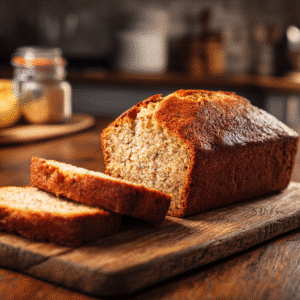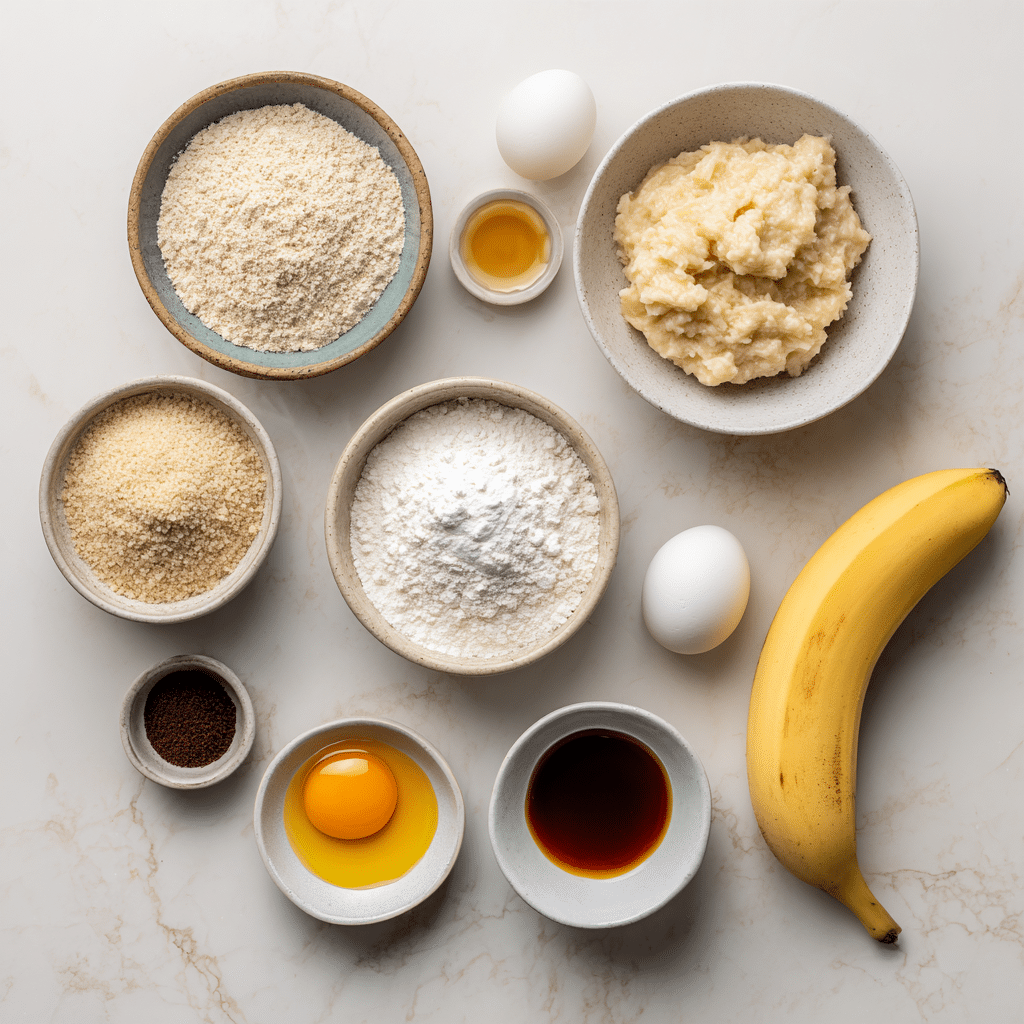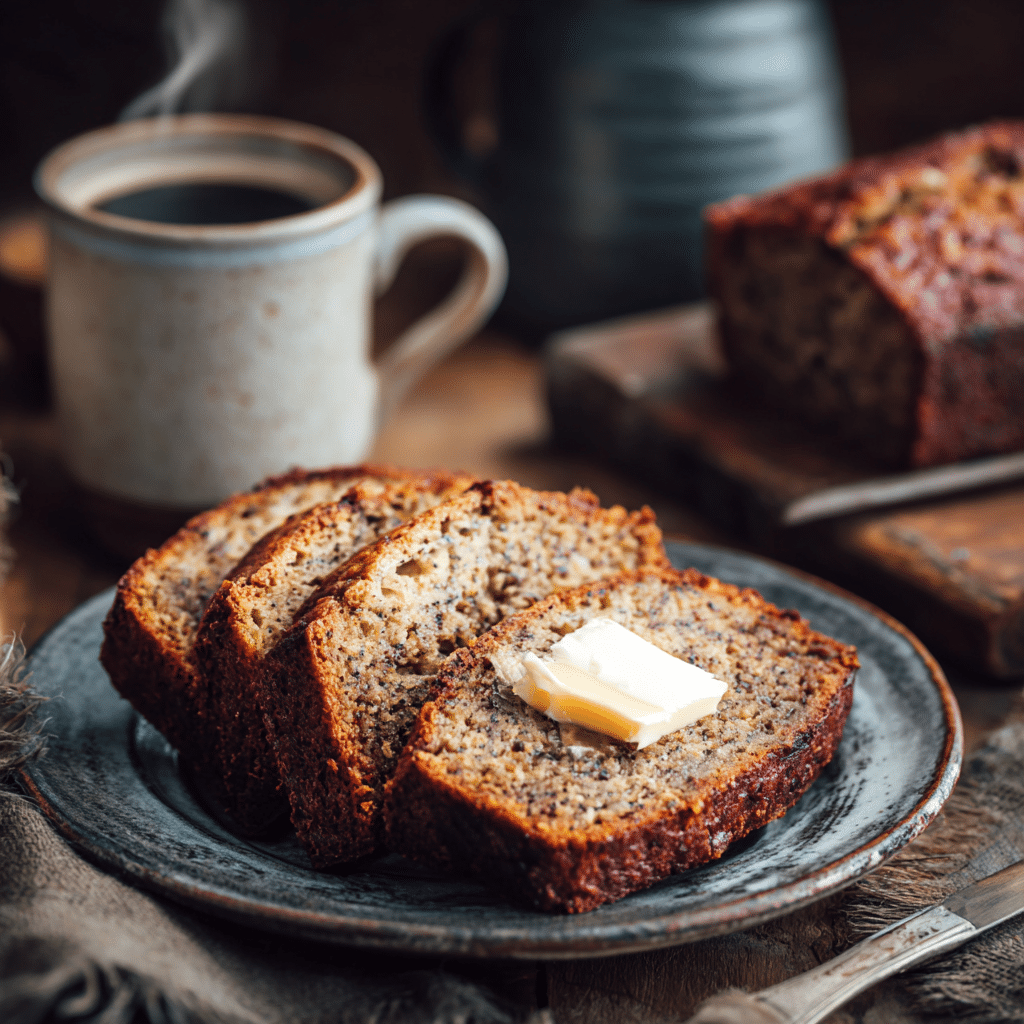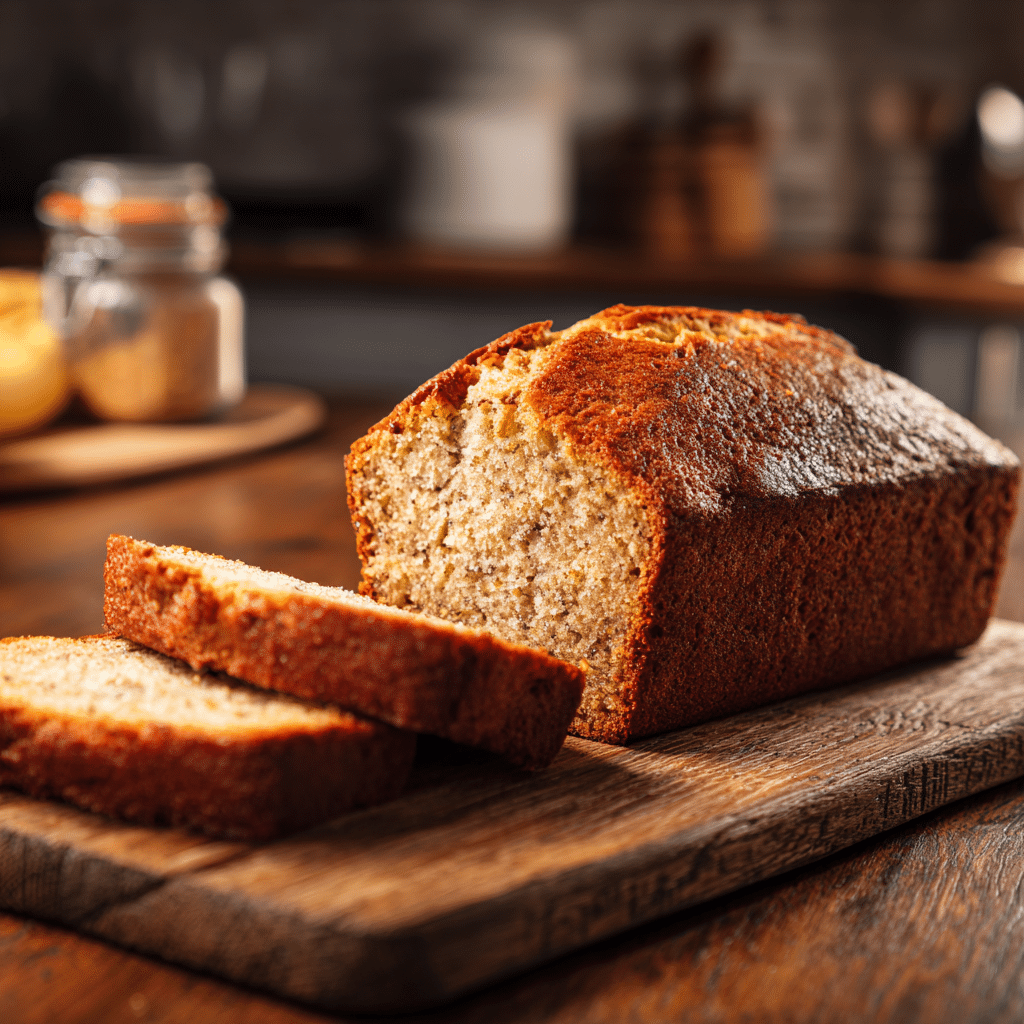A gluten free banana bread recipe should never feel like a compromise and this one doesn’t. Moist, naturally sweet, and full of that comforting banana flavor, this loaf brings together the best of both worlds: indulgent taste and gluten free peace of mind. In this guide, I’ll show you how to bake a foolproof loaf, avoid common gluten free baking mistakes, and get the texture just right. Plus, we’ll answer the top questions people ask about making banana bread gluten free. Whether it’s your first time baking gluten free or you’re a seasoned pro, this recipe is the one you’ll come back to again and again.
Table of Contents
My Journey to the Perfect Gluten Free Banana Bread Recipe
The Tuscan Chef Meets American Comfort Baking
Growing up in Tuscany, banana bread wasn’t something we made. Our tables were filled with olive oil cakes and almond biscotti. But when I moved to the U.S., I was introduced to this comforting classic. Sweet, tender, and full of banana flavor it quickly became a favorite. Yet, once I found out I was gluten-intolerant, banana bread became one of those nostalgic foods I missed the most.
I tried dozens of versions before creating a gluten free banana bread recipe that reminded me of the original texture and warmth. I still remember the first batch that actually worked moist, golden brown, with just the right crumb. It was a moment of triumph. And honestly, it was better than many gluten filled versions I’d tried before.

Gluten Free Banana Bread Recipe
Ingredients
- 1 ½ cups mashed overripe bananas about 3 large bananas
- 2 eggs
- ¼ cup melted coconut oil
- ¼ cup maple syrup
- ¼ cup coconut sugar
- 1 tsp vanilla extract
- 1 ½ cups almond flour
- ¼ cup tapioca starch
- 1 tsp baking soda
- ½ tsp salt
- 1 tsp apple cider vinegar
- ¼ cup almond milk
- Optional: ½ cup chopped walnuts or chocolate chips
Instructions
- Preheat oven to 325°F (160°C) and grease a loaf pan.
- In a large bowl, mash bananas and mix in eggs, coconut oil, maple syrup, coconut sugar, and vanilla.
- Stir in almond flour, tapioca starch, baking soda, salt, apple cider vinegar, and almond milk. Mix until just combined.
- Fold in optional add-ins like chocolate chips or nuts if using.
- Let the batter rest for 10 minutes.
- Pour into the prepared loaf pan and smooth the top.
- Bake for 60–70 minutes, tenting with foil halfway through to prevent over-browning.
- Test with a toothpick; it should come out with moist crumbs.
- Cool completely before slicing for best texture.
Notes
Nutrition
Cracking the Code on Texture and Moisture
The biggest challenge was preventing dryness and gumminess. Many gluten-free loaves fell apart or baked into dense bricks. The secret? A balance of flours, ripe bananas, and the right liquid to dry ratio. I started with almond flour and added a touch of tapioca starch for structure. Then came coconut oil and maple syrup adding moisture without overwhelming the flavor.
When I published my gluten-free dairy-free banana bread, it resonated with readers who wanted a soft, rich loaf without gluten, dairy, or complicated steps. The beauty of this recipe is how flexible it is. You can make it in one bowl and even throw in chocolate chips or nuts.
Pair it with a cozy morning or gift it to a friend this gluten free banana bread recipe is more than just food. It’s comfort, tradition, and health wrapped into one loaf.
Mastering Ingredients for the Best Gluten Free Banana Bread

Choosing the Right Gluten Free Flour Blend
One of the most common questions I get is: What’s the best gluten free flour to use for banana bread? The answer is a blend because no single flour can do it all. A good mix usually includes a base flour like brown rice or almond, a starch like tapioca or potato, and a binding agent such as xanthan gum.
For this gluten free banana bread recipe, I like to use almond flour for richness and moisture, paired with tapioca starch to give it that soft, sliceable texture. You can also try my version made with coconut flour if you’re grain free, but remember: coconut flour absorbs more moisture, so you’ll need more eggs and liquid. My no-knead gluten-free bread post explains more about balancing flour types.
If you’re short on time, use a reliable 1-to-1 gluten free flour blend with xanthan gum already included. Brands like King Arthur and Bob’s Red Mill work well. Just be sure to let your batter rest for 10 minutes before baking it allows the starches to hydrate and improves the final crumb.
Bananas, Sweeteners, and Moisture Boosters
The riper the bananas, the better. We’re talking deep yellow skins with plenty of brown spots. Overripe bananas give you natural sweetness, flavor depth, and moisture key to a good gluten free banana bread recipe. You’ll need about 1 ½ cups of mashed banana (roughly 3 large ones).
For sweeteners, I go with a combo of maple syrup and coconut sugar. They’re lower glycemic and add a subtle caramel note. You can substitute honey or brown sugar, depending on your preference.
To keep the loaf moist, I use melted coconut oil and a splash of almond milk. Don’t skip the fat it helps bind the loaf and prevent dryness, as explained in my soft homemade gluten-free bread article. Apple cider vinegar also helps activate the baking soda, giving your loaf lift and softness.
Tips & Tricks for a Foolproof Gluten Free Banana Bread Recipe

Avoiding the #1 Mistake in Gluten-Free Banana Bread
It’s tempting to rush the process, but the most common mistake when making banana breadgluten free or not is underbaking. A beautiful golden crust can fool you into thinking it’s done when the center is still wet. Always test with a toothpick, and make sure it comes out clean from the middle.
For best results, bake your gluten free banana bread recipe low and slow. I use 325°F (160°C) for about 60–70 minutes. This gives the batter time to cook through without drying out the edges. I also tent foil loosely over the top halfway through to prevent over-browning.
Another pro tip: never overmix your batter. Gluten-free flours can turn gummy if mixed too much. Just stir until combined, pour into a greased loaf pan, and let it rest for a few minutes before baking. This helps with structure and reduces cracking.
Want to see these steps in action? Check out the texture tips I used in gluten-free dinner rolls they apply perfectly here too.
Flavor Add-Ins That Work Every Time
Once you’ve mastered the base recipe, it’s time to make it your own. My favorite variation includes dark chocolate chunks and chopped walnuts. But you can go tropical with shredded coconut and pineapple, or try fall vibes with cinnamon and pecans.
For a low sugar version, add blueberries like in my gluten-free blueberry muffins. They add moisture and a burst of natural sweetness.
Spices like cinnamon, nutmeg, and vanilla extract are essential to deepening the banana flavor. Don’t skip the salt, either it balances all the sweetness and makes the other ingredients shine.
This part of the gluten free banana bread recipe is where your creativity shines. Mix-ins, toppings, even swirl ins like almond butter or jam are fair game.
Solving Common Problems in Your Gluten Free Banana Bread Recipe

Why Your Gluten Free Banana Bread Might Be Dry
One of the most frequent issues with any gluten free banana bread recipe is dryness. Without gluten to hold moisture, the loaf can turn crumbly or dense. But with a few adjustments, you can fix this fast.
Start by using overripe bananas. They’re crucial for sweetness and softness. You’ll need about 1½ cups mashed anything less and your gluten free banana bread recipe may come out tough. Also, be cautious with flour. Too much coconut flour, for instance, can soak up all your liquid. Use a balanced mix or stick to a reliable 1-to-1 gluten free blend.
Another tip: check your oven. Baking even 5 minutes too long can lead to dryness. I always test the center with a toothpick. If it comes out with moist crumbs (not batter), it’s done. I also rest the loaf overnight, wrapped tight, for the best texture the next day this trick also works for my gluten-free zucchini bread.
Can You Use Gluten Free Plain Flour for Banana Bread?
Yes, you can definitely use gluten free plain flour in a banana bread recipe. However, you need to make sure it contains xanthan gum or a similar binder. If it doesn’t, add ¼ teaspoon per cup of flour to help your loaf hold together.
In my tested gluten free banana bread recipe, plain flour worked great with just a little extra banana and moisture from coconut oil. It produced a soft, sliceable loaf, just like the one in my gluten-free dairy-free banana bread version.
Plain gluten-free flour is convenient and works beautifully just remember to balance it with moisture and avoid overmixing. That’s the secret to a banana bread that tastes anything but plain.
Conclusion
When made with the right ingredients and a little care, a gluten free banana bread recipe can be every bit as satisfying as the traditional kind. From choosing the right flour blend to using ultra ripe bananas and not overbaking, each step matters. I’ve tested dozens of versions to bring you a loaf that’s moist, sweet, and perfectly sliceable ideal for breakfast, snacking, or sharing with friends.
This recipe isn’t just about avoiding gluten it’s about baking something that feels comforting and indulgent without compromise. So grab those ripe bananas and get baking. You’re going to love every bite.
What is the best gluten free flour to use for banana bread?
The best flour for a gluten free banana bread recipe is a blend of almond flour and tapioca starch. Almond flour provides richness and softness, while tapioca adds elasticity and structure. A 1-to-1 all-purpose gluten-free flour blend with xanthan gum also works well for convenience and consistent results.
What is the trick to making good gluten free bread?
The key trick is maintaining moisture and proper binding. Since gluten free flours don’t naturally bind like wheat, you need ingredients like eggs, mashed bananas, and xanthan gum. Also, let your batter rest before baking. This hydrates the flours and helps develop structure, just like in my soft homemade gluten-free bread.
What is the number one mistake made when making banana bread?
Overbaking is the most common mistake. A loaf may look golden on the outside while still undercooked in the center. Always test with a toothpick and aim for moist crumbs. Another common issue is not using ripe enough bananas—they’re essential to both moisture and sweetness in a gluten free banana bread recipe.
Can you make banana bread with gluten-free plain flour?
Yes, you can. Just check the label if your flour doesn’t have xanthan gum, add ¼ teaspoon per cup. Gluten-free plain flour makes a great base when paired with enough moisture-rich ingredients. For best results, follow a trusted recipe like this one to guide your ratios.
Why is my gluten-free banana bread so dry?
Dry banana bread usually comes from not enough banana or fat, or overbaking. Be sure your bananas are overripe, and don’t skimp on oil or milk. You can also try folding in yogurt or applesauce to retain softness. Check out my gluten-free carrot cake recipe for more moist baking tips.

